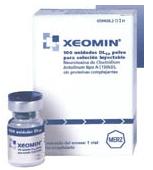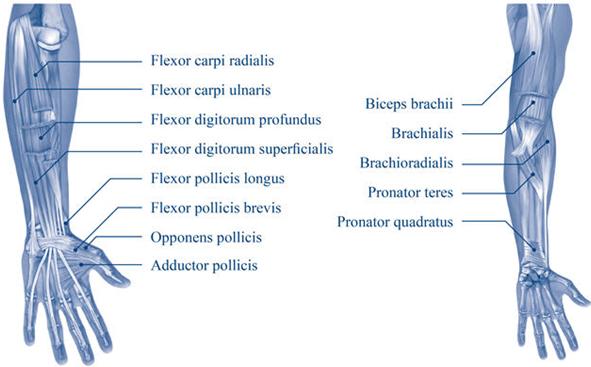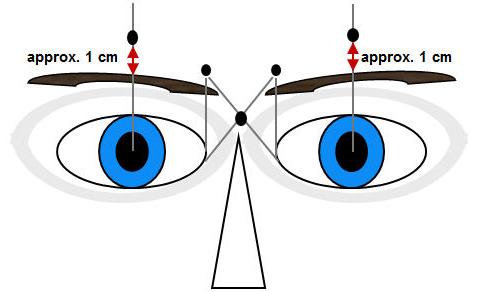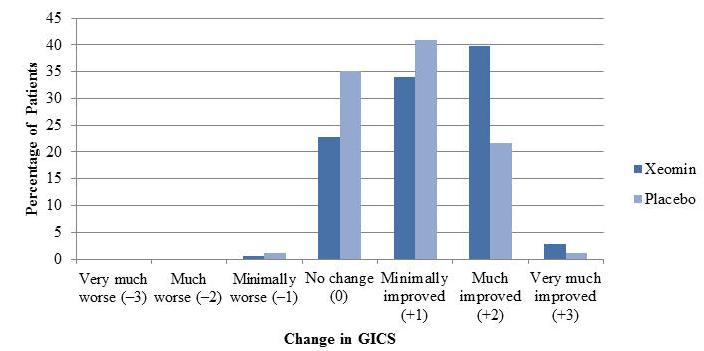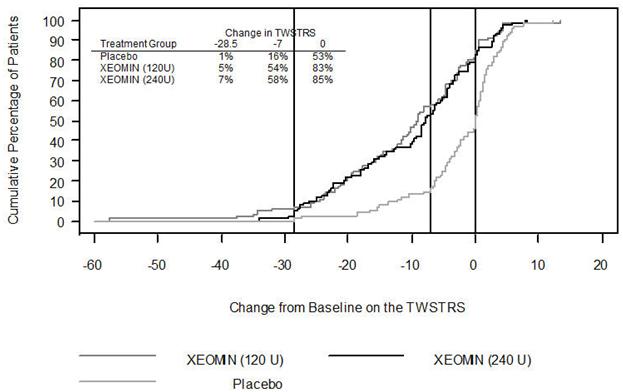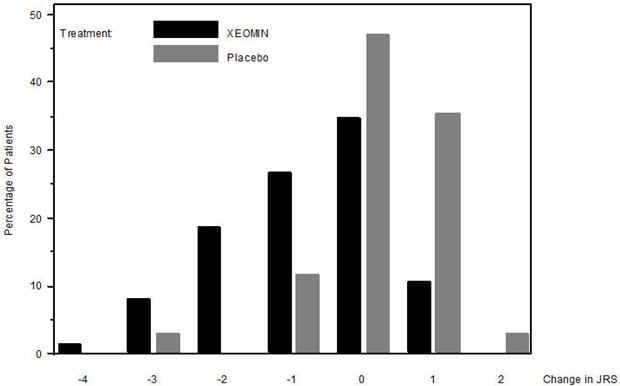|
新生物制品Xeomin(肉毒毒素类型A[incobotulinumtoxinA])治疗颈部肌张力障碍和眼睑痉挛
XEOMIN is an acetylcholine release inhibitor and neuromuscular blocking agent indicated for the treatment or improvement of adult patients with: upper limb spasticity (1.1) cervical dystonia (1.2) blepharospasm with onabotulinumtoxinA (Botox®) prior treatment (1.3) temporary improvement in the appearance of moderate to severe glabellar lines with corrugator and/or procerus muscle activity (1.4) DOSAGE AND ADMINISTRATION Upper limb spasticity, cervical dystonia, and blepharospasm: the optimum dose, frequency, and number of injection sites in the treated muscle(s) should be based on severity and prior treatment response; individualize dosing for each patient: Upper Limb Spasticity in Adults: the recommended total dose is up to 400 Units no sooner than every 12 weeks (2.2) Cervical Dystonia: recommended initial total dose is 120 Units per treatment session (2.3) Blepharospasm: base initial dosing on previous dosing for onabotulinumtoxinA (Botox); if not known, the recommended starting dose is 1.25 Units-2.5 Units per injection site (2.4) Glabellar Lines: recommended dose is 20 Units per treatment session divided into five equal intramuscular injections of 4 Units each (two injections in each corrugator muscle and one injection in the procerus muscle; wait a minimum of three months before retreatment (2.5) Reconstituted XEOMIN: is intended for intramuscular injection only (2.7) use for only one injection session and for only one patient (2.7) instructions are specific for 50 unit, 100 unit, and 200 unit vials (2.7) store in a refrigerator (2°C to 8°C) and use within 24 hours (2.7) DOSAGE FORMS AND STRENGTHS For injection: 50 Units, 100 Units, or 200 Units lyophilized powder in a single-dose vial for reconstitution with preservative–free 0.9% Sodium Chloride Injection, USP (3) CONTRAINDICATIONS Known hypersensitivity to the active substance botulinum neurotoxin type A or to any of the excipients (4.1) Infection at the proposed injection sites (4.2) WARNINGS AND PRECAUTIONS Respiratory, speech, or swallowing difficulties: Increased risk if bilateral neck muscle injections are needed or with pre-existing muscular disorders; immediate medical attention may be required (5.1, 5.3) The potency Units of XEOMIN are not interchangeable with other preparations of botulinum toxin products (5.2) Corneal exposure and ulceration: protective measures may be required (5.4) Risk of ptosis: follow dosage recommendations (5.5) ADVERSE REACTIONS The most commonly observed adverse reactions at rates specified below and greater than placebo are: Upper Limb Spasticity: (≥2% of patients) seizure, nasopharyngitis, dry mouth, upper respiratory tract infection (6.1) Cervical Dystonia: (≥5% of patients) dysphagia, neck pain, muscle weakness, injection site pain, and musculoskeletal pain (6.1) Blepharospasm: (≥5% of patients) eyelid ptosis, dry eye, dry mouth, diarrhea, headache, visual impairment, dyspnea, nasopharyngitis, and respiratory tract infection (6.1) Glabellar Lines: (>1% of patients) headache (6.1) To report SUSPECTED ADVERSE REACTIONS, contact Merz Pharmaceuticals, LLC at 888-493-6646 or FDA at 1-800-FDA-1088 or www.fda.gov/medwatch. DRUG INTERACTIONS Aminoglycoside antibiotics or other agents that interfere with neuromuscular transmission may potentiate the effect of XEOMIN; co-administer only with caution and close observation (7) USE IN SPECIFIC POPULATIONS Pregnancy: based on animal data, may cause fetal harm (8.1) Pediatric Use: XEOMIN has not been studied in the pediatric age group and is therefore not recommended in pediatric patients (8.4) See 17 for PATIENT COUNSELING INFORMATION and Medication Guide. Revised: 12/2015 FULL PRESCRIBING INFORMATION: CONTENTS* 1 INDICATIONS AND USAGE 1.1 Upper Limb Spasticity XEOMIN (incobotulinumtoxinA) is indicated for the treatment of upper limb spasticity in adult patients. 1.2 Cervical Dystonia XEOMIN (incobotulinumtoxinA) is indicated for the treatment of adults with cervical dystonia in both botulinum toxin-naïve and previously treated patients. 1.3 Blepharospasm XEOMIN (incobotulinumtoxinA) is indicated for the treatment of adults with blepharospasm who were previously treated with onabotulinumtoxinA (Botox). 1.4 Glabellar Lines XEOMIN (incobotulinumtoxinA) is indicated for the temporary improvement in the appearance of moderate to severe glabellar lines associated with corrugator and/or procerus muscle activity in adult patients. 2 DOSAGE AND ADMINISTRATION 2.1 Instructions for Safe Use The potency Units of XEOMIN (incobotulinumtoxinA) for injection are specific to the preparation and assay method utilized. They are not interchangeable with other preparations of botulinum toxin products and, therefore, units of biological activity of XEOMIN cannot be compared to or converted into Units of any other botulinum toxin products assessed with any other specific assay method [see Warnings and Precautions (5.2) and Description (11)]. Reconstituted Xeomin is intended for intramuscular injection only. The recommended maximum cumulative dose for any indication should not exceed 400 Units in a treatment session. 2.2 Upper Limb Spasticity The dosage, frequency, and number of injection sites should be tailored to the individual patient based on the size, number, and location of muscles to be treated, severity of spasticity, presence of local muscle weakness, patient's response to previous treatment, and adverse event history with XEOMIN. The frequency of XEOMIN treatments should be no sooner than every 12 weeks. In spasticity patients not previously treated with botulinum toxins, initial dosing should begin at the low end of the recommended dosing range and titrated as clinically necessary. Most patients in clinical studies were retreated between 12-14 weeks. Table 1: XEOMIN Dosing by Muscle for Treatment of Upper Limb Spasticity
Reconstituted XEOMIN is intended for intramuscular injection only. If proposed injection sites are marked with a pen, the product must not be injected through the pen marks; otherwise a permanent tattooing effect may occur. The number of injection sites is dependent upon the size of the muscle to be treated and the volume of reconstituted XEOMIN injected. XEOMIN should be injected carefully when injected at sites close to sensitive structures, such as the carotid artery, lung apices, and esophagus. Before administering XEOMIN, the physician should be familiar with the patient's anatomy and any anatomic alterations, e.g., due to prior surgical procedures. Upper Limb Spasticity and Cervical Dystonia A suitable sterile needle (e.g., 26-gauge (0.45 mm diameter), 37 mm length for superficial muscles; or 22-gauge (0.70 mm diameter), 75 mm length for injections into deeper muscles) should be used in the administration in the treatment of upper limb spasticity and cervical dystonia. Localization of the involved muscles with electromyographic guidance or nerve stimulation techniques may be useful. Blepharospasm A suitable sterile needle (e.g., 30-gauge (0.40 mm diameter), 12.5 mm length should be used in the administration in the treatment of blepharospasm. Glabellar Lines A suitable sterile needle 30-33 gauge (0.3-0.2 mm diameter), 13 mm length should be used in the administration in the treatment of glabellar lines. 2.9 Monitoring to Assess Effectiveness The median first onset of XEOMIN effect occurs within seven days after injection. The typical duration of effect of each treatment is up to 3 months; however, the effect may last significantly longer, or shorter, in individual patients. 3 DOSAGE FORMS AND STRENGTHS For injection: 50 Units, 100 Units, or 200 Units lyophilized powder in a single-dose vial for reconstitution only with preservative-free 0.9% Sodium Chloride Injection, USP. 4 CONTRAINDICATIONS 4.1 Hypersensitivity Hypersensitivity reactions have been reported with botulinum toxin products (anaphylaxis, serum sickness, urticaria, soft tissue edema, and dyspnea). If serious and/or immediate hypersensitivity reactions occur further injection of XEOMIN should be discontinued and appropriate medical therapy immediately instituted. The use of XEOMIN in patients with a known hypersensitivity to any botulinum neurotoxin or to any of the excipients (human albumin, sucrose), could lead to a life-threatening allergic reaction. XEOMIN is contraindicated in patients with known hypersensitivity to any botulinum toxin preparation or to any of the components in the formulation [see Warnings and Precautions (5.3) and Description (11)]. 4.2 Infection at Injection Site Use in patients with an infection at the injection site could lead to severe local or disseminated infection. XEOMIN is contraindicated in the presence of infection at the proposed injection site(s). 5 WARNINGS AND PRECAUTIONS 5.1 Spread of Toxin Effect Postmarketing safety data from XEOMIN and other approved botulinum toxins suggest that botulinum toxin effects may, in some cases, be observed beyond the site of local injection. The symptoms are consistent with the mechanism of action of botulinum toxin and may include asthenia, generalized muscle weakness, diplopia, blurred vision, ptosis, dysphagia, dysphonia, dysarthria, urinary incontinence, and breathing difficulties. These symptoms have been reported hours to weeks after injection. Swallowing and breathing difficulties can be life threatening and there have been reports of death related to the spread of toxin effects. The risk of symptoms is probably greatest in children treated for spasticity but symptoms can occur in adults treated for spasticity and other conditions, and particularly in those patients who have underlying conditions that would predispose them to these symptoms. In unapproved uses, including spasticity in children, and in approved indications, symptoms consistent with spread of toxin effect have been reported at doses comparable to or lower than doses used to treat cervical dystonia. Patients or caregivers should be advised to seek immediate medical care if swallowing, speech, or respiratory disorders occur. 5.2 Lack of Interchangeability between Botulinum Toxin Products The potency Units of XEOMIN are specific to the preparation and assay method utilized. They are not interchangeable with the other preparations of botulinum toxin products and, therefore, Units of biological activity of XEOMIN cannot be compared to or converted into Units of any other botulinum toxin products assessed with any other specific assay method [see Description (11)]. 5.3 Dysphagia and Breathing Difficulties Treatment with XEOMIN and other botulinum toxin products can result in swallowing or breathing difficulties. Patients with pre-existing swallowing or breathing difficulties may be more susceptible to these complications. In most cases, this is a consequence of weakening of muscles in the area of injection that are involved in breathing or swallowing. When distant effects occur, additional respiratory muscles may be involved [See Warnings and Precautions (5.1)]. Deaths as a complication of severe dysphagia have been reported after treatment with botulinum toxin. Dysphagia may persist for several months, and require use of a feeding tube to maintain adequate nutrition and hydration. Aspiration may result from severe dysphagia and is a particular risk when treating patients in whom swallowing or respiratory function is already compromised. Treatment of cervical dystonia with botulinum toxins may weaken neck muscles that serve as accessory muscles of ventilation. This may result in critical loss of breathing capacity in patients with respiratory disorders who may have become dependent upon these accessory muscles. There have been post-marketing reports of serious breathing difficulties, including respiratory failure, in patients with cervical dystonia treated with botulinum toxin products. Patients with smaller neck muscle mass and patients who require bilateral injections into the sternocleidomastoid muscles have been reported to be at greater risk of dysphagia. In general, limiting the dose injected into the sternocleidomastoid muscle may decrease the occurrence of dysphagia. Patients treated with botulinum toxin may require immediate medical attention should they develop problems with swallowing, speech or respiratory disorders. These reactions can occur within hours to weeks after injection with botulinum toxin [See Warnings and Precautions (5.1) and Adverse Reactions (6.1)]. Patients with neuromuscular disorders with peripheral motor neuropathic diseases, amyotrophic lateral sclerosis, or neuromuscular junctional disorders (e.g., myasthenia gravis or Lambert-Eaton syndrome) may be at increased risk for severe dysphagia and respiratory compromise from typical doses of XEOMIN. 5.4 Corneal Exposure, Corneal Ulceration, and Ectropion in Patients Treated for Blepharospasm Reduced blinking from injection of botulinum toxin products in the orbicularis muscle can lead to corneal exposure, persistent epithelial defect and corneal ulceration, especially in patients with VII nerve disorders. Careful testing of corneal sensation in eyes previously operated upon, avoidance of injection into the lower lid area to avoid ectropion, and vigorous treatment of any epithelial defect should be employed. This may require protective drops, ointment, therapeutic soft contact lenses, or closure of the eye by patching or other means. Because of its anticholinergic effects, XEOMIN should be used with caution in patients at risk of developing narrow angle glaucoma. To prevent ectropion, botulinum toxin products should not be injected into the medial lower eyelid area. Ecchymosis easily occurs in the soft tissues of the eyelid. Immediate gentle pressure at the injection site can limit that risk. 5.5 Risk of Ptosis in Patients Treated for Glabellar Lines Do not exceed the recommended dosage and frequency of administration of XEOMIN. In order to reduce the complication of ptosis the following steps should be taken: Avoid injection near the levator palpebrae superioris, particularly in patients with larger brow depressor complexes. Corrugator injections should be placed at least 1 cm above the bony supraorbital ridge. 5.6 Human Albumin and Transmission of Viral Diseases This product contains albumin, a derivative of human blood. Based on effective donor screening and product manufacturing processes, it carries an extremely remote risk for transmission of viral diseases. A theoretical risk for transmission of Creutzfeldt-Jakob disease (CJD) is also considered extremely remote. No cases of transmission of viral diseases or CJD have ever been reported for albumin. 6 ADVERSE REACTIONS The following adverse reactions to XEOMIN are discussed in greater detail in other sections of the labeling: Spread of Effects from Toxin [see Warnings and Precautions (5.1)] Lack of Interchangeability between Botulinum Toxin Products [see Warnings and Precautions (5.2)] Dysphagia and Breathing Difficulties [see Warnings and Precautions (5.3)] Corneal Exposure, Corneal Ulceration, and Ectropion in Patients Treated with XEOMIN for Blepharospasm [see Warnings and Precautions (5.4)] Risk of Ptosis in Patients Treated for Glabellar Lines [see Warnings and Precautions (5.5)] Human Albumin and Transmission of Viral Diseases [see Warnings and Precautions (5.6)] 6.1 Clinical Trials Experience Because clinical trials are conducted under widely varying conditions, adverse reaction rates observed in the clinical trials of a drug cannot be directly compared to rates in the clinical trials of another drug and may not reflect the rates observed in practice. Upper Limb Spasticity Table 3 lists the most common (≥2%) adverse reactions following injection of XEOMIN in two placebo-controlled, Phase 3 studies in patients with upper limb spasticity. Study 1 and Study 2 were both double-blind, placebo-controlled studies, with an open-label extension [see Clinical Studies (14.1)]. In the controlled portion of these studies, 283 patients received ≥120 Units to 400 Units, of which 217 patients received at least 400 units of XEOMIN, and 182 patients received placebo. XEOMIN-treated patients were 20-79 years old (mean 56 years), and were predominantly male (58%) and white (84%). Table 3: Most Common Adverse Reactions (≥2%) and Greater for XEOMIN than Placebo: Double-Blind Phase of Placebo-Controlled Upper Limb Spasticity Study 1 and Study 2
The data described below reflect exposure to a single intramuscular dose of XEOMIN in a placebo-controlled, Phase 3 trial in patients with cervical dystonia [see Clinical Studies (14.2)]. In this study, 159 patients received XEOMIN (78 were randomized to receive a total dose of 120 Units, and 81 were randomized to receive a total dose of 240 Units). XEOMIN-treated patients were 18 to 79 years old (mean 53 years), and were predominantly female (66%) and Caucasian (91%). At study baseline, approximately 25% had mild, 50% had moderate, and 25% had severe cervical dystonia. Approximately 61% of XEOMIN-treated patients had previously received another botulinum toxin type A product. Common adverse events (≥5% in any XEOMIN treatment group) observed in patients who received XEOMIN (120 Units or 240 Units) included dysphagia, neck pain, muscle weakness, injection site pain, and musculoskeletal pain. Table 4: Most Common Adverse Reactions (≥5%) and Greater than Placebo: Double-Blind Phase of Cervical Dystonia Clinical Trial
In the placebo-controlled Phase 3 trial in patients with blepharospasm previously treated with onabotulinumtoxinA (Botox) [see Clinical Studies (14.3)], 74 patients received XEOMIN at a mean dose of approximately 33 Units per eye (minimum 10 Units, maximum 50 Units). XEOMIN-treated patients were 22 to 79 years of age (mean 62 years), predominantly female (65%), Caucasian (79%), and had a mean time since diagnosis of approximately 5 years. The adverse events occurring in ≥5% of XEOMIN-treated patients and greater than placebo in the Phase 3 study were eyelid ptosis, dry eye, dry mouth, diarrhea, headache, visual impairment, dyspnea, nasopharyngitis, and respiratory tract infection. No serious adverse events occurred in patients who received XEOMIN; one placebo-treated patient experienced a serious adverse event (dyspnea). Table 5: Most Common Adverse Reactions (≥5%) and Greater than Placebo: Double-Blind Phase of Blepharospasm Clinical Trial
Glabellar Lines In three placebo-controlled trials in 803 subjects with glabellar lines, 535 subjects received a single dose of 20 Units XEOMIN and 268 subjects received placebo. XEOMIN treated subjects were 24 to 74 years old, and were predominantly female (88%). The most frequent adverse reactions in XEOMIN treated subjects were: headache 29 (5.4%), facial paresis 4 (0.7%), injection site hematoma 3 (0.6%) and eyelid edema 2 (0.4%). Four serious adverse events occurred in two placebo-treated subjects. Six XEOMIN treated subjects experienced six serious adverse events. All serious adverse events were assessed as unrelated to study drug. The adverse reactions below reflect exposure to XEOMIN with glabellar lines in placebo-controlled studies. Adverse reactions are adverse events in which there is some basis to believe there is a causal relationship between the drug and the occurrence of the adverse event. Because clinical trials are conducted under widely varying conditions, adverse reaction rates observed in the clinical trials of a drug cannot be directly compared to rates in the clinical trials of another drug and may not reflect the rates observed in practice. Table 6: Adverse Reactions in Placebo-Controlled Glabellar Lines Trials
6.2 Immunogenicity As with all therapeutic proteins, there is a potential for immunogenicity. The incidence of antibody formation is highly dependent on the sensitivity and specificity of the assay. In addition, the observed incidence of antibody positivity in an assay may be influenced by several factors including assay methodology, sample handling, timing of sample collection, concomitant medications, and underlying disease. For these reasons, comparison of the incidence of antibodies across products in this class may be misleading. 6.3 Postmarketing Experience The following adverse reactions have been reported during post-approval use of XEOMIN. Because these reactions are reported voluntarily from a population of uncertain size, it is not always possible to reliably estimate their frequency or establish a causal relationship to drug exposure: eye swelling, eyelid edema, dysphagia, nausea, flu-like symptoms, injection site pain, injection site reaction, allergic dermatitis, localized allergic reactions like swelling, edema, erythema, pruritus or rash, herpes zoster, muscular weakness, muscle spasm, dysarthria, myalgia and hypersensitivity. 7 DRUG INTERACTIONS No formal drug interaction studies have been conducted with XEOMIN. Co-administration of XEOMIN and aminoglycoside antibiotics or other agents interfering with neuromuscular transmission, e.g., tubocurarine-type muscle relaxants, should only be performed with caution as these agents may potentiate the effect of the toxin. Use of anticholinergic drugs after administration of XEOMIN may potentiate systemic anticholinergic effects. The effect of administering different botulinum toxin products at the same time or within several months of each other is unknown. Excessive neuromuscular weakness may be exacerbated by administration of another botulinum toxin prior to the resolution of the effects of a previously administered botulinum toxin. Excessive weakness may also be exaggerated by administration of a muscle relaxant before or after administration of XEOMIN. 8 USE IN SPECIFIC POPULATIONS 8.1 Pregnancy Pregnancy Category C: There are no adequate and well-controlled studies in pregnant women. XEOMIN should be used during pregnancy only if the potential benefit justifies the potential risk to the fetus. XEOMIN was embryotoxic in rats and increased abortions in rabbits when given at doses higher than the maximum recommended human dose (MRHD) for cervical dystonia (120 Units) on a body weight basis. When XEOMIN was administered intramuscularly to pregnant rats during organogenesis (3 Units/kg, 10 Units/kg, or 30 Units/kg on gestational days [GDs] 6, 12, and 19; or 7 Units/kg on GDs 6 to 19; or 2 Units/kg, 6 Units/kg, or 18 Units/kg on GDs 6, 9, 12, 16, and 19), decreases in fetal body weight and skeletal ossification were observed at doses that were also maternally toxic. The no-effect level for embryotoxicity in rats was 6 Units/kg (3 times the MRHD for cervical dystonia on a body weight basis). Intramuscular administration to pregnant rabbits during organogenesis (1.25 Units/kg, 2.5 Units/kg, or 5.0 Units/kg on GDs 6, 18, and 28) resulted in an increased rate of abortion at the highest dose, which was also maternally toxic. In rabbits, the no-effect level for increased abortion was 2.5 Units/kg (similar to the MRHD for cervical dystonia on a body weight basis). 8.3 Nursing Mothers It is not known whether botulinum toxin type A is excreted in human milk. Because many drugs are excreted in human milk, caution should be exercised when XEOMIN is administered to a nursing woman. 8.4 Pediatric Use Safety and effectiveness of XEOMIN in patients less than 18 years of age have not been established [see Warnings and Precautions (5.1)]. 8.5 Geriatric Use Upper Limb Spasticity Of the total number of 283 patients treated with XEOMIN in placebo controlled studies in upper limb spasticity, 70 patients were 65 years of age and over, and 7 patients were 75 years of age and over. No overall differences in safety or effectiveness were observed between older and younger patients. Other clinical studies have not identified differences in responses between older and younger patients, but increased sensitivity in older patients cannot be ruled out. Cervical Dystonia In the Phase 3 study in cervical dystonia [see Clinical Studies (14.2)], 29 patients were older than 65 years of age, including 19 patients who received XEOMIN and 10 patients who received placebo. Of these, ten (53%) XEOMIN-treated patients and four (40%) placebo-treated patients experienced an adverse event. For patients over 65 years of age treated with XEOMIN, the most common adverse events were dysphagia (4 patients, 21%) and asthenia (2 patients, 11%). One XEOMIN-treated patient (5%) experienced severe dizziness. Blepharospasm In the Phase 3 study in blepharospasm [see Clinical Studies (14.3)], 41 patients were older than 65 years of age, including 29 of 75 patients (39%) who received XEOMIN and 12 of 34 patients (35%) who received placebo. Of these patients, 22 of 29 (76%) XEOMIN-treated patients, compared with 7 of 12 (58%) placebo-treated patients, experienced an adverse event. One XEOMIN-treated patient experienced severe dysphagia. Glabellar Lines There are limited clinical data with XEOMIN in subjects over 65 years of age and over in clinical studies with glabellar lines. Of the total number of subjects in the placebo-controlled clinical studies GL1 and GL2, 21 (4%) subjects were 65 and over. Efficacy was observed in 20% (3/15) of XEOMIN subjects 65 years and over. For the entire safety database of geriatric subjects, there was no increase in the incidence of adverse events related to treatment with XEOMIN. 10 OVERDOSAGE Excessive doses of XEOMIN may be expected to produce neuromuscular weakness with a variety of symptoms. Respiratory support may be required where excessive doses cause paralysis of the respiratory muscles. In the event of overdose, the patient should be medically monitored for symptoms of excessive muscle weakness or muscle paralysis [See Warnings and Precautions (5.1, 5.3)]. Symptomatic treatment may be necessary. Symptoms of overdose are not likely to be present immediately following injection. Should accidental injection or oral ingestion occur, the person should be medically supervised for several weeks for signs and symptoms of excessive muscle weakness or paralysis. There is no significant information regarding overdose from clinical studies of XEOMIN. In the event of overdose, antitoxin raised against botulinum toxin is available from the Centers for Disease Control and Prevention (CDC) in Atlanta, GA. However, the antitoxin will not reverse any botulinum toxin-induced effects already apparent by the time of antitoxin administration. In the event of suspected or actual cases of botulinum toxin poisoning, please contact your local or state Health Department to process a request for antitoxin through the CDC. If you do not receive a response within 30 minutes, please contact the CDC directly at 770-488-7100. More information can be obtained at http://www.cdc.gov/ncidod/srp/drugs/formulary.html#1a. 11 DESCRIPTION The active ingredient of XEOMIN is botulinum toxin type A produced from fermentation of Hall strain Clostridium botulinum serotype A. The botulinum toxin complex is purified from the culture supernatant and then the active ingredient is separated from the proteins (hemagglutinins and non-hemagglutinins) through a series of steps yielding the active neurotoxin with molecular weight of 150 kDa, without accessory proteins. XEOMIN is a sterile white to off-white lyophilized powder intended for intramuscular injection after reconstitution with preservative-free 0.9% Sodium Chloride Injection, USP (3). One vial of XEOMIN contains 50 Units, 100 Units, or 200 Units of incobotulinumtoxinA, human albumin (1 mg), and sucrose (4.7 mg). The primary release procedure for XEOMIN uses a cell-based potency assay to determine the potency relative to a reference standard. One Unit corresponds to the median intraperitoneal lethal dose (LD50) in mice. As the method for conducting the assay is specific to XEOMIN, Units of biological activity of XEOMIN cannot be converted into Units of any other botulinum toxin assessed with other specific assays. 12 CLINICAL PHARMACOLOGY 12.1 Mechanism of Action XEOMIN blocks cholinergic transmission at the neuromuscular junction by inhibiting the release of acetylcholine from peripheral cholinergic nerve endings. This inhibition occurs according to the following sequence: neurotoxin binding to cholinergic nerve terminals, internalization of the neurotoxin into the nerve terminal, translocation of the light-chain part of the molecule into the cytosol of the nerve terminal, and enzymatic cleavage of SNAP25, a presynaptic target protein essential for the release of acetylcholine. Impulse transmission is re-established by the formation of new nerve endings. 12.2 Pharmacodynamics The return of increased muscle tone following injection typically occurs within 3 to 4 months. 12.3 Pharmacokinetics General characteristics of the active substance: Using currently available analytical technology, it is not possible to detect XEOMIN in the peripheral blood following intramuscular injection at the recommended doses. 13 NONCLINICAL TOXICOLOGY 13.1 Carcinogenesis, Mutagenesis, Impairment of Fertility Carcinogenesis Studies to evaluate the carcinogenic potential of XEOMIN have not been conducted. Mutagenesis Genotoxicity studies have not been conducted for XEOMIN. Impairment of Fertility In a fertility and early embryonic development study in rabbits, males and females were dosed with XEOMIN (1.25 Units/kg, 2.5 Units/kg, or 3.5 Units/kg) intramuscularly every two weeks for 5 and 3 doses, respectively, beginning 2 weeks prior to mating. No effects on mating or fertility were observed. The highest dose tested is approximately twice the maximum recommended human dose for cervical dystonia (120 Units) on a body weight basis. 14 CLINICAL STUDIES 14.1 Upper Limb Spasticity The efficacy and safety of XEOMIN for the treatment of upper limb spasticity was evaluated in two Phase 3, randomized, multi-center, double-blind studies. Study 1 and Study 2 were both prospective, double-blind, placebo-controlled, randomized, multi-center trials with an open-label extension period (OLEX) to investigate the efficacy and safety of XEOMIN in the treatment of post-stroke spasticity of the upper limb. For patients who had previously received botulinum toxin treatment in any body region, Study 1 and Study 2 required that ≥ 12 months and ≥ 4 months, respectively, had passed since the most recent botulinum toxin administration. Study 1 consisted of a 12-week main phase followed by three 12-week OLEX treatment cycles for a total exposure duration of 48 weeks. The study included 317 treatment-naïve patients who were at least three months post-stroke in the main study period (210 XEOMIN and 107 placebo). During the main period, XEOMIN (fixed total dose of 400 Units) and placebo were administered intramuscularly to the defined primary target clinical pattern chosen from among the flexed elbow, flexed wrist, or clenched fist patterns and to other affected muscle groups. 296 treated patients completed the main phase and participated in the first OLEX cycle. Each OLEX cycle consisted of a single treatment session (XEOMIN 400 Units total dose, distributed among all affected muscles) followed by a 12 week observation period. Study 2 consisted of a 12 - 20 week main phase followed by an OLEX period of 48 –69 weeks for up to 89 weeks of exposure to XEOMIN. The study included 148 treatment-naïve and pre-treated patients with a confirmed diagnosis of post-stroke spasticity of the upper limb who were at least six months post-stroke (73 XEOMIN and 75 placebo). During the main period, for each patient, the clinical patterns of flexed wrist and clenched fist were treated with fixed doses (90 Units and 80 Units, respectively). Additionally, if other upper limb spasticity patterns were present, the elbow, forearm and thumb muscles could be treated with fixed doses of XEOMIN per muscle. 145 patients completed the main phase and participated in the OLEX period, during which time the dosing of each involved muscle could be adapted individually. During the main and OLEX periods, the maximum total dose per treatment session and 12-week interval was 400 Units. The average XEOMIN doses injected into specific muscles and the number of injection sites per muscle in Study 1 and Study 2 are presented in Table 7. Table 7: Doses Administered to Individual Muscles (Main Period) in Study 1 and Study 2 Intent to Treat (ITT)
Table 8: Efficacy Results by Patterns of Spasticity in Study 1, Week 4
p<0.001 The co-primary efficacy variable of Study 1 was the Investigator's Global Impression of Change Scales (GICS) after 4 Weeks of treatment with XEOMIN or placebo. The GICS is a global measure of a subject's functional improvement. Investigators were asked to evaluate the subject's global change in spasticity of the upper limb due to treatment, compared to the condition before the last injection. The response was assessed using a 7-point Likert scale that ranges from –3 (very much worse) to +3 (very much improved). A greater percentage of XEOMIN-treated subjects (43%) than placebo-treated subjects (23%) reported 'very much improved' and 'much improved' in their spasticity (see Figure 3). Figure 3: Investigator's GICS in Study 1
The mean age of the study patients was 53 years, and 66% of the patients were women. At study baseline, 61% of patients had previously received a botulinum toxin as treatment for cervical dystonia. The study was completed by 94% of study patients. Three patients discontinued the study prematurely due to adverse events: two patients in the 240 Unit group experienced musculoskeletal pain and muscle weakness, and one patient in the 120 Unit group experienced nausea and dizziness. The primary efficacy endpoint was the change in the TWSTRS total score from baseline to Week 4 post-injection, in the intent-to-treat (ITT) population, with missing values replaced by the patient's baseline value. In the ITT population, the difference between the XEOMIN 240 Unit group and the placebo group in the change of the TWSTRS total score from baseline to Week 4 was -9.0 points, 95% confidence interval (CI) -12.0; -5.9 points; the difference between the XEOMIN 120 Unit group and the placebo group in the change of the TWSTRS total score from baseline to Week 4 was -7.5 points, 95% CI -10.4; -4.6 points. Figure 4 illustrates the cumulative percentage of patients from each of the three treatment groups who had attained the specified change in TWSTRS Score from baseline versus 4 weeks post-injection. Three change scores have been identified for illustrative purposes, and the percent of patients in each group achieving that result is shown. Figure 4: Cumulative Percentage of Patients with Specified Changes from Baseline TWSTRS Total Score at Week 4
The mean age of the study patients was 62 years, and 65% of the patients were women. The study was completed by 94% of study patients. Approximately one third of patients had other dystonic phenomena; in all but 1% this was limited to facial, cervical, perioral and mandibular muscles. No patients discontinued the study prematurely due to adverse events. The primary efficacy endpoint was the change in the JRS Severity subscore from baseline to Week 6 post-injection, in the intent-to-treat (ITT) population, with missing values replaced by the patient's most recent value (i.e., last observation carried forward). In the ITT population, the difference between the XEOMIN group and the placebo group in the change of the JRS Severity subscore from baseline to Week 6 was -1.0 (95% CI -1.4; -0.5) points. Comparison of the XEOMIN group to the placebo group was statistically significant at p<0.001. Figure 5: Frequency Distribution of Changes from Baseline JRS Severity Subscore at Week 6
Figure 6: Percentage of Subjects with Composite Treatment Success by Visit – Observed Cases (GL-1 and GL-2)
Unopened vials of XEOMIN can be stored at room temperature 20°C to 25°C (68°F to 77°F), in a refrigerator at 2°C to 8°C (36°F to 46°F), or a freezer at -20°C to -10°C (-4°F to 14°F). Do not use after the expiration date on the vial. 16.3 Handling XEOMIN is reconstituted prior to use with sterile preservative-free 0.9% Sodium Chloride Injection, USP [see Dosage and Administration (2.6)]. XEOMIN should not be used if the reconstituted solution has a cloudy appearance or contains floccular or particulate matter. Any reconstituted toxin solution for injection that has been stored for more than 24 hours, as well as any unused solution for injection, should be discarded. https://dailymed.nlm.nih.gov/dailymed/drugInfo.cfm?setid=3f35d6e0-3450-4abc-a0da-cc7b277e7c6e | ||||||||||||||||||||||||||||||||||||||||||||||||||||||||||||||||||||||||||||||||||||||||||||||||||||||||||||||||||||||||||||||||||||||||||||||||||||||||||||||||||||||||||||||||||||||||||||||||||||||||||||||||||||||||||||||||||||||||||||||||||||||||||||||||||||||||||||||||||||||||||||||||||||||||||||||||||||||||||||||||||||||||||||||||||||||||||||||||||||||||||||||||||||||||||||||||||||||||||||||||||||||||||||||||||||||||||||||||||||||||||||||||||||||||||||||||||||||||||||||||


